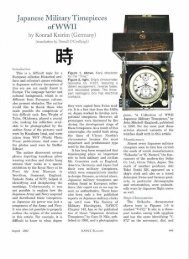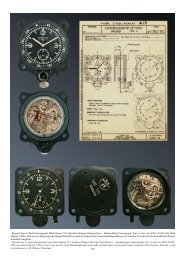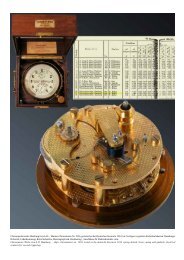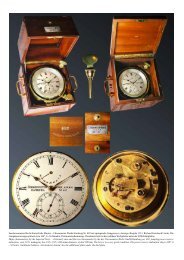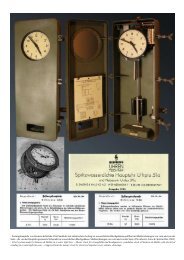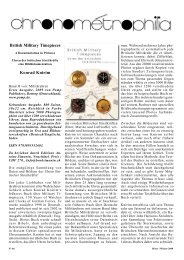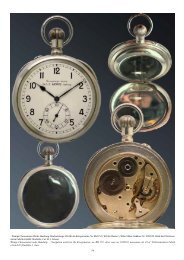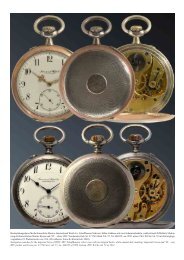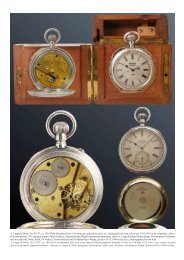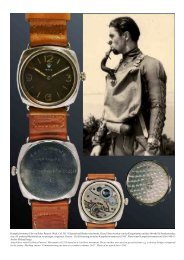Konrad Knirim BRITISH MILITARY TIMEPIECES - Militäruhren ...
Konrad Knirim BRITISH MILITARY TIMEPIECES - Militäruhren ...
Konrad Knirim BRITISH MILITARY TIMEPIECES - Militäruhren ...
You also want an ePaper? Increase the reach of your titles
YUMPU automatically turns print PDFs into web optimized ePapers that Google loves.
<strong>Konrad</strong> <strong>Knirim</strong><br />
<strong>BRITISH</strong> <strong>MILITARY</strong> <strong>TIMEPIECES</strong><br />
Published by Verlag Pomp, Bottrop, Germany (info@pomp.de).<br />
Hard covers, 800 pages, copiously, overwhelmingly illustrated<br />
ISBN 978-3-89355-Z60-3. Price €178 from amazon.de<br />
Yet again, the Book Gods<br />
have smiled on us. Or on<br />
me, at least, given my<br />
obsession with British<br />
military watches. <strong>Konrad</strong><br />
<strong>Knirim</strong>, who produced<br />
the astonishing<br />
Military Timepieces Vol<br />
I: 150 Years Watches<br />
and Clocks of German<br />
Forces, has followed<br />
it with an even more<br />
impressive tome. To<br />
give it its full title, the<br />
second in the series<br />
is called Military Timepieces<br />
Vol II: British Military Timepieces - Watches and Clocks<br />
of Their Majesties Forces. And, yes, the author acknowledges<br />
the incongruity of a German enthusiast authoring a book that<br />
should have been produced by a British historian. Then again,<br />
it took the Germans to save the Mini, Bentley and Rolls- Royce,<br />
so why should we be surprised?<br />
<strong>Knirim</strong> deals with this irony in the engrossing preface, which<br />
explains how he sacrificed his own collection of British military<br />
watches a few years ago and had to enlist the assistance<br />
of collectors in the UK. The first page stopped me dead in my<br />
tracks: KK (him, not me) revealed that<br />
one of the collaborators was a collector<br />
named ‚Phil‘, based in Sittingbourne,<br />
Kent - a mere two train stops away from<br />
me. I gotta find this guy! Then, on the<br />
next page, <strong>Knirim</strong> includes a photo of<br />
part of his own, now-departed 1990s<br />
collection, some 20 or 30 watches in<br />
a pile, any of which a collector would<br />
love to own.<br />
<strong>Knirim</strong> states that on a key trip to the<br />
UK, he spent four days visiting eight<br />
collectors and shooting thousands of<br />
images of British military clocks and<br />
watches. Other occasions involved<br />
calling on important museums, those<br />
forays augmented by visits to the watch<br />
manufacturers and suppliers<br />
- Jaeger-LeCoultre,<br />
Omega and many others<br />
- ensuring that <strong>Knirim</strong> left<br />
no source untapped. The<br />
list of acknowledgements<br />
is impressive, including<br />
our own Tim Treffry,<br />
vintage watch dealer<br />
Justin Koullapis and<br />
Ziggy Wesolowski, author<br />
of a seminal book<br />
on military watches in<br />
general.<br />
<strong>Knirim</strong> also admits that<br />
his task was made easier by the research opportunities<br />
of the internet, but he‘s being modest: like its predecessor,<br />
this book is one of the most extensively research I‘ve seen<br />
relating to any watch history. Indeed, the first impression upon<br />
thumbing through the book is one of being overwhelmed by<br />
a surfeit of information.<br />
How to account for so much material? It should be pointed<br />
out that in the hierarchy of military watches, the British and<br />
the Germans are neck-and-neck for the sheer variety of timepieces,<br />
but one could cautiously attribute to the UK the greater<br />
number. As a result, this volume is over<br />
150 pages longer than its predecessor,<br />
but it‘s not simply because there were<br />
more British watches and clocks.<br />
Instead, the extra pages involve a<br />
liberty taken by <strong>Knirim</strong>: he included<br />
a section that deals with the watches<br />
of the Colonies, Great Britain‘s noncolonial<br />
Allies and - oddly - the Japanese<br />
forces. I do not wish to attempt<br />
to read <strong>Knirim</strong>‘s mind, but I would<br />
posit, because no other countries can<br />
match Great Britain‘s or German‘s<br />
horological prolificacy when it comes<br />
to military watches, that this was a<br />
convenient way of dealing with the<br />
rest of the world, Thus I also imagine<br />
QP Devoted to Fine Watches Bookshelf: Review by Ken Kessler Issue Thirty Six 2009
that <strong>Knirim</strong> could do a third volume, which would add Italian,<br />
South American, Middle Eastern and other forces‘ watches.<br />
Keeping it uniform with the previous volume, <strong>Knirim</strong> mixes<br />
archival photography with newly generated images, cramming<br />
in as much as a page can hold. The layouts range from a single<br />
chronometer and its movement enjoying an entire page, to<br />
group shots of watches of a specific type. The four 1970s RAF<br />
chronographs, for example, are shown dial side,<br />
arranged vertically, and next to them are their<br />
corresponding watch backs, with a third column<br />
showing the inner cases and a fourth revealing<br />
the movements. Official documents appear,<br />
as do advertisements, where appropriate to<br />
impart the feel of the era.<br />
Peppered throughout are period photographs<br />
adding context to the models,<br />
something exploited perfectly for the section<br />
on modern military watches. There are<br />
groups of photos, for example, of the wrists<br />
and hands of soldiers on duty in Iraq, showing<br />
precisely what timepieces they use, almost with<br />
the suggestion that <strong>Knirim</strong> found some way to<br />
have them posed for his book.<br />
These contrast wonderfully with images of soldiers from past<br />
wars, including great photos of submarine and aircraft crews,<br />
in which the photos were clear enough, or the sub- j e c t s<br />
positioned in such a way that the watches can<br />
be identified. One can only marvel at the levels<br />
of detective work <strong>Knirim</strong> had to undertake to<br />
find such images. For me, the most poignant<br />
photographs of all were formed by quartets<br />
of soldiers from wwl, sporting some of<br />
the world‘s first wristwatches. Suffice it to<br />
say that, on visual terms alone, amongst<br />
other military watch titles, this book has no<br />
peers. Except for its companion volume.<br />
After the preface, <strong>Knirim</strong> winds the clock way<br />
back to the very earliest timekeepers, beginning<br />
with John Harrison and the requirements<br />
of the first marine navigators. This is followed<br />
by a chapter on chronometers and clocks, and<br />
one on deck and pocket watches. We don‘t reach wristwatches<br />
until page 4901 This section takes up over 200 pages, itself<br />
broken down into headings covering every type of wristwatch<br />
and each brand of the services, and <strong>Knirim</strong> knows just how to<br />
portion out the text: individual watches are covered with an<br />
amount of prose indicative of their importance.<br />
Because his appreciation for the bigger picture is so complete,<br />
<strong>Knirim</strong> knows how to handle the specifics. Thus we<br />
find in-depth coverage of IWC‘s Mk X and Mk 11,<br />
Lemania watches, the Rolex Submariners commissioned<br />
for the Royal Navy, a section about the<br />
Bonklip bracelet, explanations of the Broad Arrow<br />
symbol, separate chapters for ‚WWW and<br />
‚ATP‘ watches, and separate descriptions<br />
of each of the suppliers, from the obvious<br />
ones such as Omega, to the obscurities like<br />
Grana. As is now expected of <strong>Knirim</strong>, who<br />
raised the bar impossibly high, there are<br />
tables of documentation, which will help collectors<br />
identify their finds. So comprehensive<br />
is this book that they‘ll probably locate photographs<br />
of the exact model, including ultra-rarities<br />
like the 1953 and 1956 Omegas, and the highly<br />
desirable Jaeger- LeCoultre variants.<br />
If the watch industry has any sense of its own worth, some<br />
horological foundation will create an annual award for the best<br />
watch titles of the year, with an eye toward recognising true<br />
scholarship. With no end in sight for the flood of<br />
watch-related books, such an honour would help<br />
to highlight the worthy titles, while ignoring the<br />
puffery and self-promotion of what are glorified<br />
catalogues. <strong>Knirim</strong>‘s book would easily walk<br />
away with the honour for 2009. This isn‘t just<br />
a great book: it‘s an important book.<br />
A reviewer can praise a book no more<br />
highly than with this closer: I wish I‘d<br />
written it.<br />
QP Devoted to Fine Watches Bookshelf: Review by Ken Kessler Issue Thirty Six 2009




